|
 |
 |
 |
 |
Seminar on Partial Differential Equations
Fall 2020
All talks in ZOOM, Friday at 2:00 PM
Click here for Fall 2019
| September 4 |
|
| September 11 |
|
| September 18 |
|
| September 25 |
|
| October 2 |
|
| October 9 |
|
| October 16 |
Kris
Jenssenn
Penn State
Title:
Self-similar Compressible Euler Flows
Abstract:
In 1942, Guderley gave examples of self-similar compressible
flows in
which a symmetric shock wave collapses at the origin and
reflects a new outgoing spherical shock. Besides their
relevance for bomb-making and Inertial Confinement Fusion,
these solutions are of interest in mathematical fluid
dynamics. In particular, they demonstrate how wave focusing
can generate unbounded solutions from bounded initial data,
also in nonlinear models. We shall report on recent work
showing that Guderley solutions provide genuine weak solutions
of the multi-d, compressible Euler system.
On the other hand, these same solutions exhibit zero pressure
regions due to vanishing temperature, and they are therefore
of border-line physicality.
To address this we show that the Euler model admits other
(self-similar) solutions which suffer blow up in amplitude,
but with everywhere strictly positive pressure. Thus, the
mechanism of wave focusing is sufficiently strong, on its own,
to generate unbounded amplitudes.
Joint work with Charis Tsikkou (University of West Virginia). |
| October 23 |
|
| October 30 |
|
| November 6 |
Stephanie
Dodson
Uiniversity of California, Davis
Title: Behavior of Spiral Wave Spectrum with a Rank-Deficient Diffusion Matrix
Abstract:
Spiral waves emerge in numerous pattern forming systems and are commonly modeled with reaction-diffusion systems. Some systems used to model biological processes, such as ion-channel models, fall under the reaction-diffusion category and have one or more non-diffusing species which results in a rank-deficient diffusion matrix. Previous research has focused on understanding the spectral stability of spiral waves, but the impact of a rank-deficient diffusion matrix on the spiral spectra are as of now unknown. In this talk, we will use a general two-variable reaction diffusion system to investigate changes in the essential and absolute spectrum of spiral waves under the cases of a diffusive and non-diffusive slow variable. The spiral spectra is found to have profound and unexpected differences for these two limits. We will present expansions for the essential spectrum curves under the two diffusion cases, and our results indicate the diffusiveless species is directly responsible for observed changes in the essential spectrum. Moreover, we predict locations for the absolute spectrum in the case of a non-diffusing slow variable. Predictions are numerically confirmed with the Barkley and Karma models. |
| November 13 |
|
| November 20 |
Jason Bramburger
University of Washington, Seattle
Title: Sharp bounds on minimum wave speeds using polynomial
optimization
Abstract:
Many monostable reaction-diffusion equations admit one-dimensional travelling waves if and only if the wave speed is sufficiently high. The values of these minimum wave speeds are not known exactly, except in a few simple cases. In this talk I will present methods for finding upper and lower bounds on minimum wave speeds by constructing trapping boundaries for dynamical systems whose heteroclinic connections correspond to the travelling wave. When the reaction-diffusion equations being studied have polynomial nonlinearities, this approach can be implemented computationally using polynomial optimization. For scalar reaction-diffusion equations, I will present a general method and apply it to a modified FKPP equation from the literature where minimum wave speeds were previously unknown. I will also discuss extensions to multi-component reaction-diffusion equations, including a cubic autocatalysis model from the literature.
|
| November 27 |
|
| December 4 |
Glenn Webb
Vanderbilt University
Title:
A Mathematical Model of CT Scans for Lung Cancer Diagnosis
Abstract:
A diffusive logistic partial differential equation is
developed
to provide a dynamic model
corresponding to the histograms of Hounsfield
units obtained from the
ground glass opacity measurements of lung CT
scans.
The model simulations provide agreement with the five
phases of
lung cancer tumor development, as pro filed by the
histograms. The model
quantifies the tumor growth
dynamics and can be used to schedule
additional CT
scans or medical procedures. The model is compared to
patient data at Vanderbilt University Veterans
Administration Hospital.
|
Small changes/shifts in the dates may
be possible.
|
 |
 |
 |
 |
|
|




